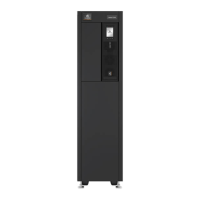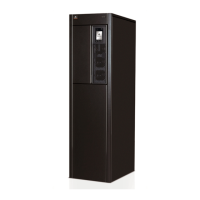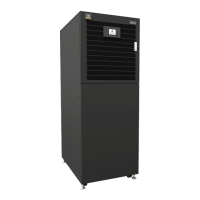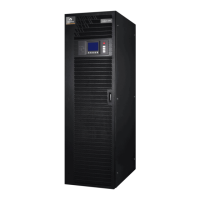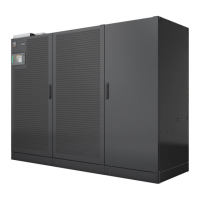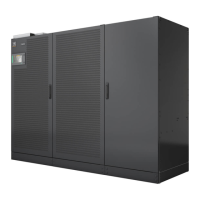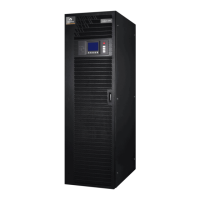Do you have a question about the Vertiv Liebert EXS 80kVA UPS and is the answer not in the manual?
Important safety instructions for personnel involved in installation and operation.
Guidelines for safe storage and operation environment to prevent product damage or risks.
Vertiv's statement on responsibility for defects or malfunctions due to misuse or external factors.
Crucial warnings for installation, operation, and servicing to prevent hazards.
Lists applicable EU directives and product standards for UPS safety and performance.
Warnings regarding disconnecting power before work and risks associated with liquid or fire.
Highlights key features of the Liebert EXS 80kVA UPS, including efficiency and capabilities.
Explains the AC-DC-AC conversion principle and the UPS single module's working.
Details connecting multiple UPS modules for increased capacity and reliability.
Lists and describes various operational states like Normal, Battery, Bypass, ECO, etc.
Covers functions like boost charge, float charge, and temperature compensation for battery health.
Details protection mechanisms like low pre-warning, EOD protection, and BCB alarms for battery safety.
Essential safety guidelines and warnings for qualified personnel during mechanical installation.
Recommendations for safely moving and transporting the UPS unit, including handling warnings.
Lists essential tools required for installation, emphasizing insulated tools for safety.
Step-by-step instructions for safely unpacking the UPS and its components.
Procedures for inspecting the UPS and its environment before installation to ensure readiness.
Specifies the ideal conditions for the UPS room, including temperature, humidity, and ventilation.
Details requirements for moving cabinets, clearance, and cable access modes for proper installation.
Provides dimensional views and diagrams of the UPS for installation planning.
Guidelines for selecting and connecting power cables for input, output, and battery systems.
Instructions for routing and connecting signal cables, ensuring proper grounding.
Overview of the front panel components including LCD, keys, and LED indicators for operation and monitoring.
Describes different screen displays like Start-up Screen, Flow Screen, and Main Menu Screen.
Lists common prompts and their meanings, guiding user interaction for commands and alerts.
Lists and explains various alarm messages the UPS may display.
Provides an overview of operating precautions and routine methods for UPS usage.
Step-by-step guide for starting the UPS in normal mode and battery mode.
Instructions for transitioning the UPS between Normal, Battery, and Bypass modes.
Outlines procedures for performing battery maintenance and capacity tests.
Describes a self-test procedure to check UPS control functions, indicators, and alarms.
Detailed steps for completely powering down the UPS, including safety considerations.
Explains the Emergency Power Off function for immediate shutdown in critical situations.
Steps to reset the UPS after an EPO event or other fault conditions.
Describes the UPS's ability to automatically restart after a mains failure if the function is enabled.
Guides users on how to change the display language of the UPS menu.
Instructions for setting the system date and time on the UPS.
Instructions for changing the default password to secure UPS access and settings.
Introduces parallel UPS systems, load sharing, and control signals via parallel cables.
Lists essential requirements for parallel UPS systems, including matching capacities and connection rules.
Outlines the installation process for parallel UPS systems, emphasizing coordination by service personnel.
Guides on checking, powering on, and performing maintenance on parallel UPS systems.
Overview and installation details for Load Bus Synchronizer (LBS) systems, ensuring synchronization of UPS outputs.
Instructions for installing communication cards in the Intellislot ports for network connectivity.
Explains the pin layout and functions of dry contact ports for external device communication.
Refers to the connection method for parallel cables used in parallel systems.
Refers to the connection method for LBS cables used in LBS systems.
Guidelines for inspecting and maintaining UPS fans, noting their expected lifespan and importance.
Crucial instructions for battery care, including temperature, charging, and handling precautions.
Procedures for periodically cleaning the UPS, focusing on ventilation holes for optimal airflow.
Steps for regularly monitoring the UPS operational status, checking for faults, and operating modes.
Procedures for verifying the correct operation of UPS functions and indicators.
A table detailing various optional accessories available for the UPS, including cables and kits.
Describes the compulsory communication cables required for parallel system configurations.
Describes the compulsory cables used for LBS systems to synchronize UPS outputs.
Lists available communication cards and temperature sensors for enhanced monitoring and connectivity.
Details the BCB box, its components, and parameters for external battery management and protection.
Information on battery cabinets used for housing batteries, BCB, and control boards.
Explains the function of the isolation transformer included at the UPS output for electrical isolation.
Information on the top fan assembly for upward air outlet and installation considerations.
Describes the IP31 kit for enhanced protection, noting potential power de-rating.
Information on the C2 shielding assembly for residential environment compliance.
Lists the UPS's compliance with various international standards for safety and EMC.
Specifies operating conditions like noise, altitude, humidity, and temperature ranges.
Provides physical specifications such as dimensions, weight, color, and protection degree.
Details the AC input voltage, range, frequency, and power factor for the rectifier.
Specifies battery type, cell configurations, and maximum charge current.
Lists output voltage, frequency, overload capacity, power factor, and efficiency.
Details bypass input voltage, overload capacity, frequency, and tolerance settings.
Configuration options for language, date, time, baud rates, and communication protocols.
Settings related to system configuration, LBS, operation modes, and auto-restart.
Parameters for system voltage, frequency, output adjustment, and bypass tolerance.
Configuration options for battery strings, capacity, equalization, testing, and UPS ID.
Configuration for general-purpose dry contact inputs and outputs for external signaling.
Settings for operational controls like turning on/off, muting alarms, and initiating tests.
Settings related to battery maintenance, equalization, and system reset procedures.
Important safety instructions for personnel involved in installation and operation.
Guidelines for safe storage and operation environment to prevent product damage or risks.
Vertiv's statement on responsibility for defects or malfunctions due to misuse or external factors.
Crucial warnings for installation, operation, and servicing to prevent hazards.
Lists applicable EU directives and product standards for UPS safety and performance.
Warnings regarding disconnecting power before work and risks associated with liquid or fire.
Highlights key features of the Liebert EXS 80kVA UPS, including efficiency and capabilities.
Explains the AC-DC-AC conversion principle and the UPS single module's working.
Details connecting multiple UPS modules for increased capacity and reliability.
Lists and describes various operational states like Normal, Battery, Bypass, ECO, etc.
Covers functions like boost charge, float charge, and temperature compensation for battery health.
Details protection mechanisms like low pre-warning, EOD protection, and BCB alarms for battery safety.
Essential safety guidelines and warnings for qualified personnel during mechanical installation.
Recommendations for safely moving and transporting the UPS unit, including handling warnings.
Lists essential tools required for installation, emphasizing insulated tools for safety.
Step-by-step instructions for safely unpacking the UPS and its components.
Procedures for inspecting the UPS and its environment before installation to ensure readiness.
Specifies the ideal conditions for the UPS room, including temperature, humidity, and ventilation.
Details requirements for moving cabinets, clearance, and cable access modes for proper installation.
Provides dimensional views and diagrams of the UPS for installation planning.
Guidelines for selecting and connecting power cables for input, output, and battery systems.
Instructions for routing and connecting signal cables, ensuring proper grounding.
Overview of the front panel components including LCD, keys, and LED indicators for operation and monitoring.
Describes different screen displays like Start-up Screen, Flow Screen, and Main Menu Screen.
Lists common prompts and their meanings, guiding user interaction for commands and alerts.
Lists and explains various alarm messages the UPS may display.
Provides an overview of operating precautions and routine methods for UPS usage.
Step-by-step guide for starting the UPS in normal mode and battery mode.
Instructions for transitioning the UPS between Normal, Battery, and Bypass modes.
Outlines procedures for performing battery maintenance and capacity tests.
Describes a self-test procedure to check UPS control functions, indicators, and alarms.
Detailed steps for completely powering down the UPS, including safety considerations.
Explains the Emergency Power Off function for immediate shutdown in critical situations.
Steps to reset the UPS after an EPO event or other fault conditions.
Describes the UPS's ability to automatically restart after a mains failure if the function is enabled.
Guides users on how to change the display language of the UPS menu.
Instructions for setting the system date and time on the UPS.
Instructions for changing the default password to secure UPS access and settings.
Introduces parallel UPS systems, load sharing, and control signals via parallel cables.
Lists essential requirements for parallel UPS systems, including matching capacities and connection rules.
Outlines the installation process for parallel UPS systems, emphasizing coordination by service personnel.
Guides on checking, powering on, and performing maintenance on parallel UPS systems.
Overview and installation details for Load Bus Synchronizer (LBS) systems, ensuring synchronization of UPS outputs.
Instructions for installing communication cards in the Intellislot ports for network connectivity.
Explains the pin layout and functions of dry contact ports for external device communication.
Refers to the connection method for parallel cables used in parallel systems.
Refers to the connection method for LBS cables used in LBS systems.
Guidelines for inspecting and maintaining UPS fans, noting their expected lifespan and importance.
Crucial instructions for battery care, including temperature, charging, and handling precautions.
Procedures for periodically cleaning the UPS, focusing on ventilation holes for optimal airflow.
Steps for regularly monitoring the UPS operational status, checking for faults, and operating modes.
Procedures for verifying the correct operation of UPS functions and indicators.
A table detailing various optional accessories available for the UPS, including cables and kits.
Describes the compulsory communication cables required for parallel system configurations.
Describes the compulsory cables used for LBS systems to synchronize UPS outputs.
Lists available communication cards and temperature sensors for enhanced monitoring and connectivity.
Details the BCB box, its components, and parameters for external battery management and protection.
Information on battery cabinets used for housing batteries, BCB, and control boards.
Explains the function of the isolation transformer included at the UPS output for electrical isolation.
Information on the top fan assembly for upward air outlet and installation considerations.
Describes the IP31 kit for enhanced protection, noting potential power de-rating.
Information on the C2 shielding assembly for residential environment compliance.
Lists the UPS's compliance with various international standards for safety and EMC.
Specifies operating conditions like noise, altitude, humidity, and temperature ranges.
Provides physical specifications such as dimensions, weight, color, and protection degree.
Details the AC input voltage, range, frequency, and power factor for the rectifier.
Specifies battery type, cell configurations, and maximum charge current.
Lists output voltage, frequency, overload capacity, power factor, and efficiency.
Details bypass input voltage, overload capacity, frequency, and tolerance settings.
Configuration options for language, date, time, baud rates, and communication protocols.
Settings related to system configuration, LBS, operation modes, and auto-restart.
Parameters for system voltage, frequency, output adjustment, and bypass tolerance.
Configuration options for battery strings, capacity, equalization, testing, and UPS ID.
Configuration for general-purpose dry contact inputs and outputs for external signaling.
Settings for operational controls like turning on/off, muting alarms, and initiating tests.
Settings related to battery maintenance, equalization, and system reset procedures.
| Power Rating | 80 kVA |
|---|---|
| Active Power | 80 kW |
| Phase | 3-phase |
| Frequency | 50/60 Hz |
| Battery Type | Valve Regulated Lead Acid (VRLA) |
| Topology | Double Conversion Online |
| Form Factor | Tower |
| Input Voltage | 380/400/415 V |
| Output Voltage | 380/400/415 V |
| Battery Runtime | Varies based on load |
| Communication Interface | SNMP |
| Operating Temperature | 0°C to 40°C |
| Relative Humidity | 0 to 95% (non-condensing) |
